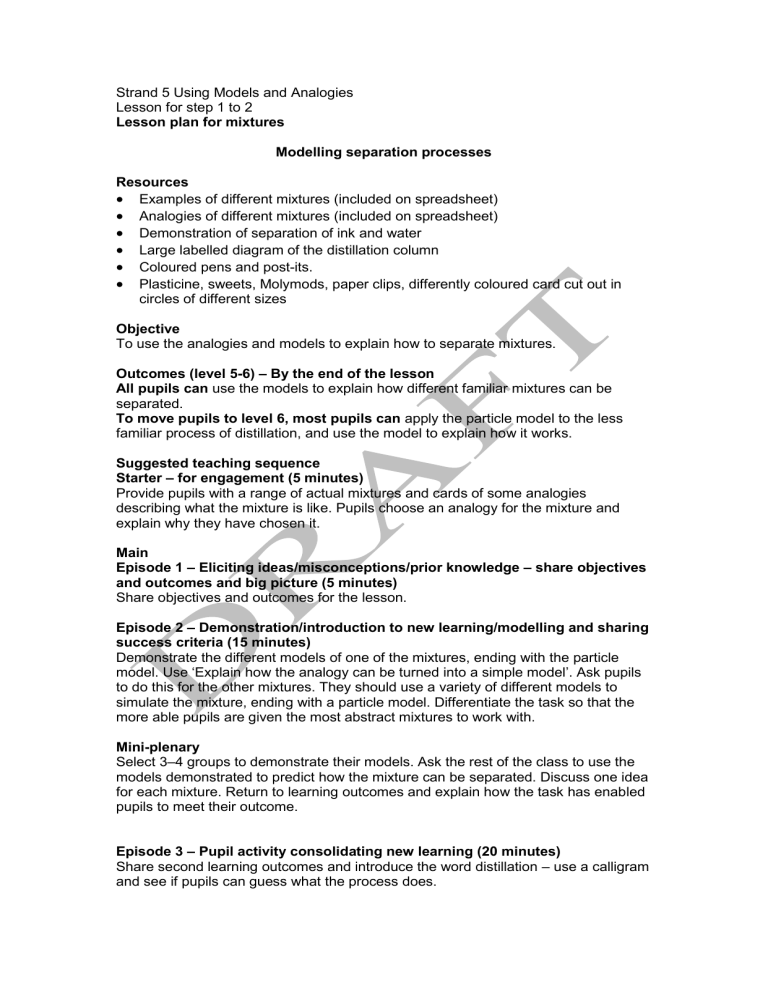Lesson plan for mixtures

Strand 5 Using Models and Analogies
Lesson for step 1 to 2
Lesson plan for mixtures
Modelling separation processes
Resources
Examples of different mixtures (included on spreadsheet)
Analogies of different mixtures (included on spreadsheet)
Demonstration of separation of ink and water
Large labelled diagram of the distillation column
Coloured pens and post-its.
Plasticine, sweets, Molymods, paper clips, differently coloured card cut out in circles of different sizes
Objective
To use the analogies and models to explain how to separate mixtures.
Outcomes (level 5-6) – By the end of the lesson
All pupils can use the models to explain how different familiar mixtures can be separated.
To move pupils to level 6, most pupils can apply the particle model to the less familiar process of distillation, and use the model to explain how it works.
Suggested teaching sequence
Starter – for engagement (5 minutes)
Provide pupils with a range of actual mixtures and cards of some analogies describing what the mixture is like. Pupils choose an analogy for the mixture and explain why they have chosen it.
Main
Episode 1 – Eliciting ideas/misconceptions/prior knowledge – share objectives and outcomes and big picture (5 minutes)
Share objectives and outcomes for the lesson.
Episode 2 – Demonstration/introduction to new learning/modelling and sharing success criteria (15 minutes)
Demonstrate the different models of one of the mixtures, ending with the particle model. Use ‘Explain how the analogy can be turned into a simple model’. Ask pupils to do this for the other mixtures. They should use a variety of different models to simulate the mixture, ending with a particle model. Differentiate the task so that the more able pupils are given the most abstract mixtures to work with.
Mini-plenary
Select 3 –4 groups to demonstrate their models. Ask the rest of the class to use the models demonstrated to predict how the mixture can be separated. Discuss one idea for each mixture. Return to learning outcomes and explain how the task has enabled pupils to meet their outcome.
Episode 3 – Pupil activity consolidating new learning (20 minutes)
Share second learning outcomes and introduce the word distillation – use a calligram and see if pupils can guess what the process does.
Introduce water and ink mixture. Use an analogy, followed by a model (e.g. particle diagram of two different liquids) to explain that different liquids have different boiling points due to the varying strength of the forces between the liquid particles. Use different thicknesses of string to show these forces for two different liquids during the role-play.
Demonstrate the ink –water distillation and discuss parts of the distillation process.
Ask pupils in pairs to think about analogies for different stages of the process. Share some prepared examples if necessary. Ask pupils, in groups of 3 –4, to use the analogies to draw particle diagrams for different stages of the process on post-its.
Episode 4 – Pupil review progress (10 minutes)
Use a large diagram of the distillation column or projected diagram – pupils stick their post-its on to the diagram. Look at the differences and ask questions about the models.
Episode 5
Plenary: Assessing the progress of pupils – have they met their learning outcomes. Reflect on the learning in the lesson – what was hard/easy – sense of achievement (10 minutes)
Return to learning outcomes.
Give pupils some make-believe scenarios from the Planet Mix-Up. Provide them with some analogies of different mixtures and some particle models of these. Ask pupils to match them up, and come up with a way of separating this unfamiliar mixture.
Mixture 1:
Analogy: This mixture is like three friends who get on really well.
Analogy: This mixture is like a trifle.
Analogy: This mixture is like a crowd of football spectators.






![afl_mat[1]](http://s2.studylib.net/store/data/005387843_1-8371eaaba182de7da429cb4369cd28fc-300x300.png)

